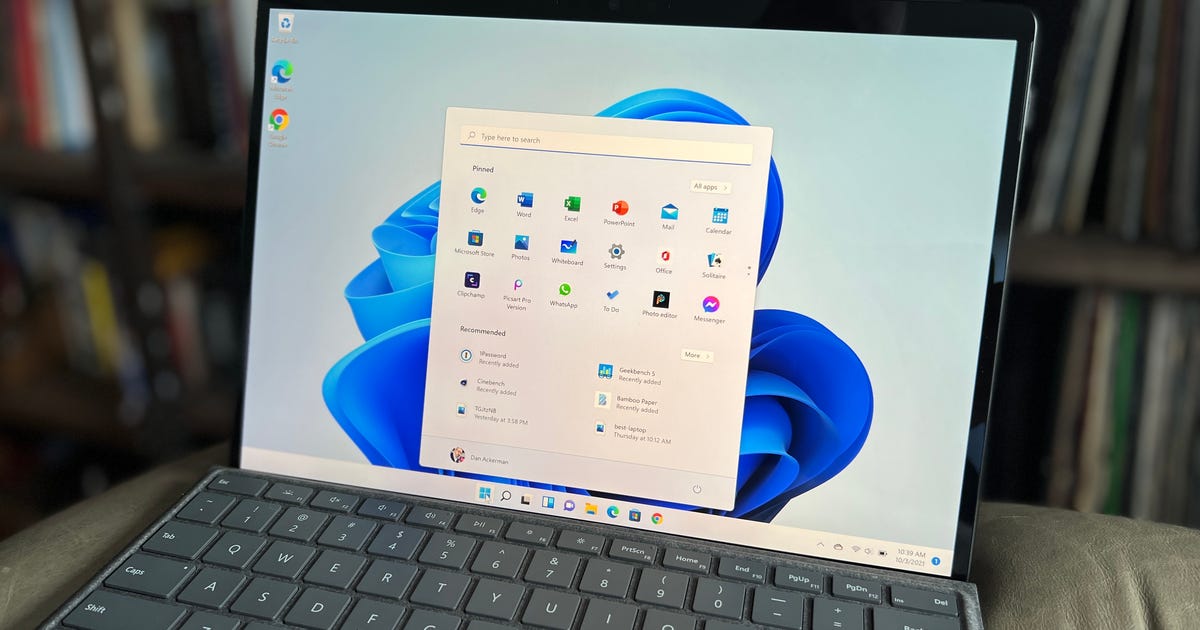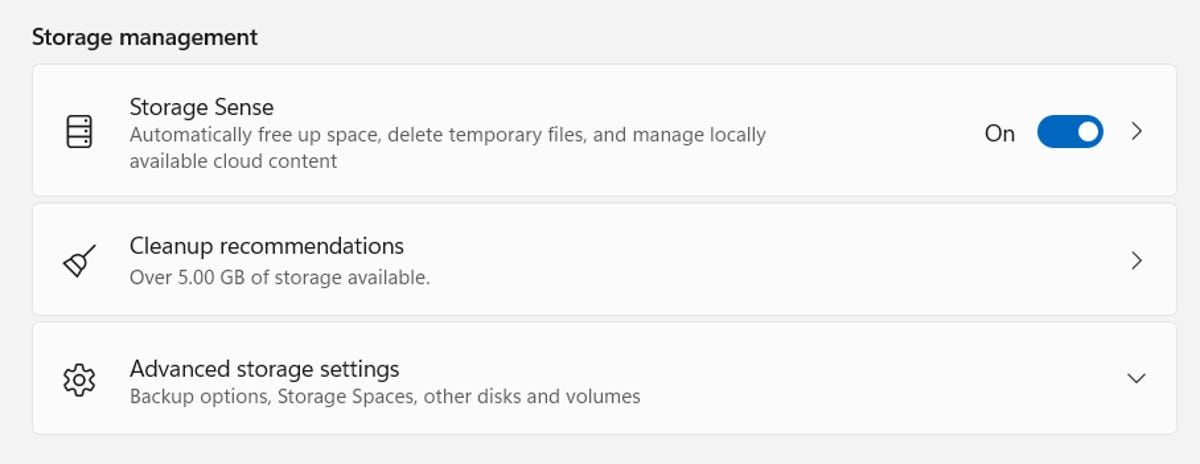How to free storage on windows 11 storage for windows 11 low storage space windows 10 windows 11 low disk space low storage space windows storage for windows 11 low on storage windows 10 not enough storage for windows 11 windows 11 local storage storage space windows 11 low storage on kindle fire

Low Storage on Windows 11? Here's How to Free Up Disk Space on Your PC
The last thing you want is a hard drive with little or no storage space. A near-full hard drive negatively affects your entire computer, which will inevitably slow it down and cause your applications to crash more frequently. The only fix really is to clean up your drive and remove large files taking up the most space, and Windows 11 makes it easy to get rid of what you don't need.
Instead of downloading third-party software to free up disk space, Windows 11 has a few settings you can configure to quickly delete temporary and system files, as well as old downloads. And if you're worried about getting rid of important files, don't fret -- Windows 11 will help you decide what to get rid of to improve your PC's performance.
On your Windows 11 computer, go to Settings -> System -> Storage. If this is your first time visiting this setting, wait a few seconds for your computer to analyze your data storage. Once Windows has collected what it needs to know, you'll be able to see your total free memory at the top of the page. Underneath that you'll see a breakdown of your storage, divided into apps and features, temporary files and other. You can also click Show more categories to view a further breakdown.
The setting we're interested in, however, is Storage Sense, which automatically frees up space on your computer whenever your disk space is low. It does this by deleting temporary files, emptying your Recycle Bin and getting rid of old downloads, in the background, without you having to manually do it.

Enable Storage Sense to make Windows 11 automatically free up space.
Nelson Aguilar/CNETTo turn on Storage Sense, simply toggle it on here. If you click the setting, you can configure several features:
- Run Storage Sense: Run Storage Sense during low disk space (default) or every day, week or month.
- Delete files in my recycle bin if they have been there for over: Choose 1 day, 14 days, 30 days (default) or 60 days.
- Delete files in my Downloads folder if they haven't been opened for more than: Choose never (default), 1 day, 14 days, 30 days or 60 days.
These Storage Sense settings can help you limit which files are removed, and when they're removed, so that you don't have to worry about any important files getting wiped from your computer.

You can configure how often Windows 11 cleans up your disk space, as well as which files it deletes and how often.
Nelson Aguilar/CNETAt the bottom of the page, you can click Run Storage Sensenow to use the feature then and there.
And if you want to get rid of more files to clear up space, use the Cleanup recommendations feature underneath Storage Sense. If you click on it, it will scan your system and recommend files for you to manually delete, such as temporary files, large or unused files, files synced with your cloud and unused apps.
Want to learn more about Windows 11? Check out the biggest differences between Windows 10 and Windows 11. Also, these are the best features on Windows 11 you need to know about. And if you haven't downloaded Windows 11 yet, here's how what you need to do.
Source
Blog Archive
-
▼
2023
(214)
-
▼
January
(80)
- Best Cheap Video Doorbells For 2022
- Dell XPS 13 (winter 2013) Review: Still Can't Touc...
- Lenovo Brings AMD To Its Gaming Laptops
- HP Elitebook Folio 9470m Review: Big Business Ultr...
- Elon Musk Shares Tesla Solarglass Pumpkin Torture ...
- Snap Snares New Users With Revamped Android App
- WhatsApp Expands Emoji Reactions For Further Messa...
- 10 Mobile Horror Games To Play In The Dark
- First Bendable OLED Gaming Monitor Announced By......
- You Don't Have To Live With These Default Windows ...
- Best Samsung Galaxy Z Flip 3 Cases
- Star Wars Costume Turns Real Two-legged Robot Into...
- Here's One Feature Samsung Could Use To One-Up Apple
- Home Equity Line Of Credit: HELOC Rates For Septem...
- Grab A Refurb 2-in-1 Microsoft Surface 3 Laptop Fo...
- 5 DIY Dog Toys You Make In Minutes
- Elon Musk Says Tesla's FSD Software Is Getting A P...
- Dorsey: Twitter 'will Probably Never' Add An Edit ...
- Get An Echo Dot For $1 When Signing Up For Amazon ...
- Apple Debuts Two New $49 Pride Edition Sport Loops...
- Low Storage On Windows 11? Here's How To Free Up D...
- Facebook Takes Center Stage In 'Super Pumped' Seas...
- Google's Pixel 6 Vs. Pixel 5: All The Biggest Diff...
- Fitbit Tips: 12 Tricks To Get The Most Out Of The ...
- HP Updates Elite Dragonfly And Folio Laptops At CE...
- The UK Will Issue Its Own NFT This Summer
- A Black Widow Pulsar Became The Heaviest Neutron S...
- CES 2021: Custom Mix Your Own Lipstick With This G...
- See The South Park Kids All Grown Up In Thanksgivi...
- Newegg's 72-hour Flash Sale Brings Big Savings On ...
- Facebook Takes Center Stage In 'Super Pumped' Seas...
- Tesla Solar Roof: The Sleekest Solar Option Isn't ...
- 3 Ways To Keep Your Heart And Brain Healthy
- CDC Recommends COVID Booster For Kids Ages 5 To 11
- Valve Confirms Steam Deck Will Be 'Multigenerational'
- After Luna Collapse, Terra Looks To New Blockchain...
- Twitter Accused Of Neglecting Security Problems: W...
- Who's Winning America's Electric Vehicle Race?
- Huawei's Legal Troubles Take A Twist With T-Mobile...
- Best Buy Will Now Haul Away Your Old TV, Appliance...
- Protecting Your Privacy In The Post-Roe US
- Amazon Uses Snapchat To Send Exclusive Deals
- 6 Ways To Haggle A Cheaper Gym Membership
- Dinosaurs Look Real In Trailer For 'Prehistoric Pl...
- Get Up To $25 Off Nintendo Switch Games Right Now
- Consumer Groups Urge Scrutiny Of Google's Fitbit B...
- Is The US Job Market Still Strong? Answers To Your...
- Google's $199 Pixel Buds Pro Add Active Noise Canc...
- Scott Hall, Pro Wrestler Known As Razor Ramon, Die...
- Hyundai Debuts Wild 670-hp Hydrogen Plug-in Hybrid...
- Final Fantasy XIV Endwalker Early Access: Start Ti...
- Best Personal Loans For Bad Credit For August 2022
- Dell XPS 13 OLED (9310) Review: Beautiful Design T...
- How To Update Disney Plus Parental Controls Now Th...
- 6 Spooky Google Home Tricks (and Treats) To Try To...
- I Used Loop To Hack My Insulin Pump To Better Cont...
- 2023 Porsche Taycan Range, Software Upgrade Coming...
- Adobe Lightroom Is Getting More Powerful With AI-b...
- Google Play Protect Helps Keep Malware Off Your Phone
- Wordle: The Absolute Best Start Words, Hints And Tips
- My Favorite 'Cheap' Motorola Phone Is On Sale For ...
- Take Your GoPro On A Dive With This Seawolf Remote...
- Twitter Bans Sharing Photos, Video Of People Witho...
- Netflix Aims To Start Charging You For Password Sh...
- Tesla Sold $936M Of Bitcoin, Kept Its Dogecoin Res...
- Tidal Adds Free Tier To Its Music Streaming Service
- Facebook Removed More Than 20 Million Posts For CO...
- Get 16 Free Kindle Kids Ebooks From Amazon For Chi...
- Alex Jones Sandy Hook Trial: Jury Finds Jones Must...
- Windows 11 Finally Adds Android Apps. Here's How T...
- 2022 Hyundai Tucson Plug-In Hybrid Review: Practic...
- Last Day To Save On Apple, Bowflex, Echo And More ...
- TikTok, YouTube, Snap Say Child Safety Is A Top Pr...
- How To Get Peacock Premium Free If You Already Pay...
- WhatsApp Starts Rolling Out Option Of Encrypted Me...
- Billions Of People Globally Still Can't Afford Sma...
- The Great Resignation Hasn't Hit School Teachers Y...
- Netflix: All The TV Shows And Movies Coming In Mar...
- 2023 BMW I4 EDrive35 Introduces A Smaller Battery,...
- One Of My Favorite Cheap Smartwatches Is Now Even ...
-
▼
January
(80)
Total Pageviews
Search This Blog
Popular Posts
-
Speech pathologist job openings, birth to 3 speech pathologist job state of kansas, speech pathologist job new zealand, traveling speech pat...
-
Br1m 21 years tobymac, br1m 21 years lyrics, br1m 21 years olds, br1m 21 years toby, br1m 21 years ago, br1m 21 years anniversary, br1m 21 y...
-
Kerastase chronologiste perle, kerastase chronologiste, kerastase chronologiste mask, kerastase chronologiste treatment, kerastase chronolog...
